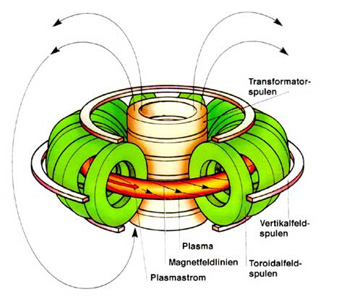tokamak

A tokamak is an experimental arrangement for achieving controlled nuclear fusion. In a tokamak, two superimposed magnetic fields enclose the plasma: this is the toroidal field generated by external coils on the one hand and the field of a flow in the plasma on the other hand. In the combined field, the field lines run helicoidally around the torus centre. In this way, the necessary twisting of the field lines and the structure of the magnetic areas are achieved.
Apart from the toroidal field generated by the external field coils and the field generated by the flow in the plasma, the tokamak requires a third vertical field (poloidal field), fixing the position of the flow in the plasma container. The flow in the plasma is mainly used to generate the enclosing magnetic field. In addition, it provides effective initial heating of the plasma. The flow in the plasma is normally induced by a transformer coil.
Owing to the transformer, the tokamak does not work continuously, but in pulse mode. Since, however, a power plant should not be operated in pulse mode for technical reasons, methods are examined to generate a continuous flow – for example by high-frequency waves.
The fusion research plant JET is built according to the tokamak principle. The fusion reactor ITER is also planned according to this principle.


